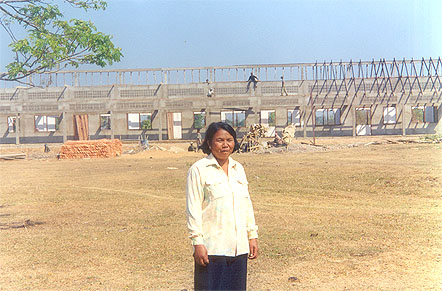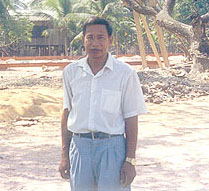The Cambodia Rural School Project
The Flavia Robinson School

Nou Samath, the director of the Flavia Robinson School (Feb.2000)
Nou Samath is the director of both The Flavia Robinson School and #49 The Guido A. & Elizabeth H. Binda Foundation School, which is located in the neighboring village. She has been the director for five years.
 Thet Sa Vorn, the district director of education, standing in front
Thet Sa Vorn, the district director of education, standing in front
of #22 The Reiko And Seiichi Kanise School, in the neighboring village
Thet Sa Vorn speaking about Nou Samath:
“Nou Samath is the only female school director in this commune.”
(Cambodian society is organized into four groups: province, district, commune, and village. There are 4,000 people in Nou Samath’s commune.)
“Most communes do not have female teachers!”
“Provincial authorities appoint school directors. They select people based on the capacity of teachers”
(One must be a teacher for several years before becoming a director.)
| on why there are not more female teachers in Cambodia: | “There are not many female teachers because women have many duties in Cambodian society” (Thet Sa Vorn is speaking of the many traditional household responsibilities of Khmer women who must raise children and take care of the home while the men raise food by farming). |
|
Nou Samath in her own words: |
|
| on her schools: | “Our schools are special because my children are so active. They love to play sports like football (soccer), vollyball, and table tennis. However, we do lack sporting equipment for the children.” |
| on her job: | “It is difficult being the director of two schools. But, the most difficult task is trying to teach children without proper materials. The teachers are always asking for more teaching aids, like books and maps for their classrooms.” |

